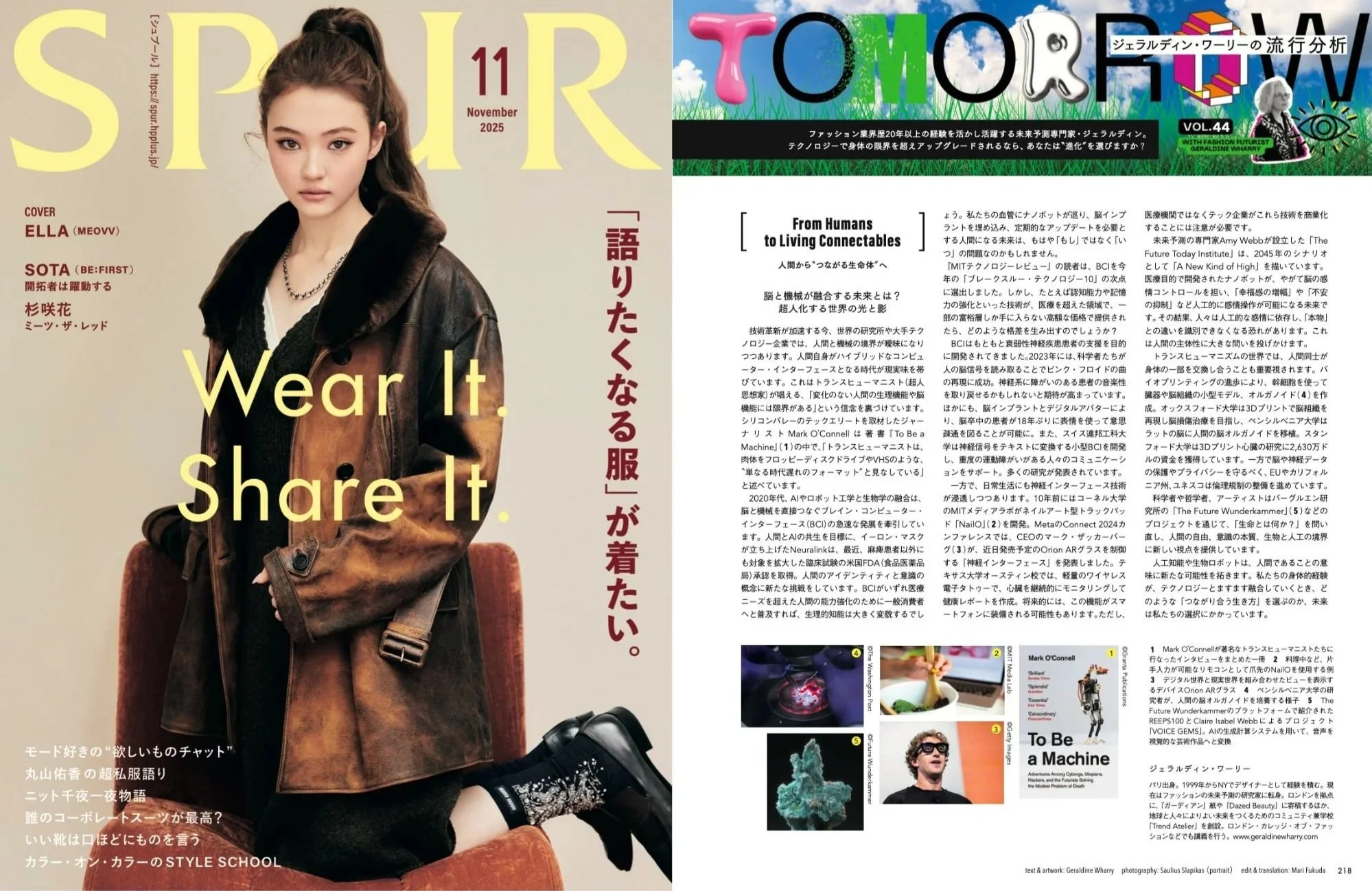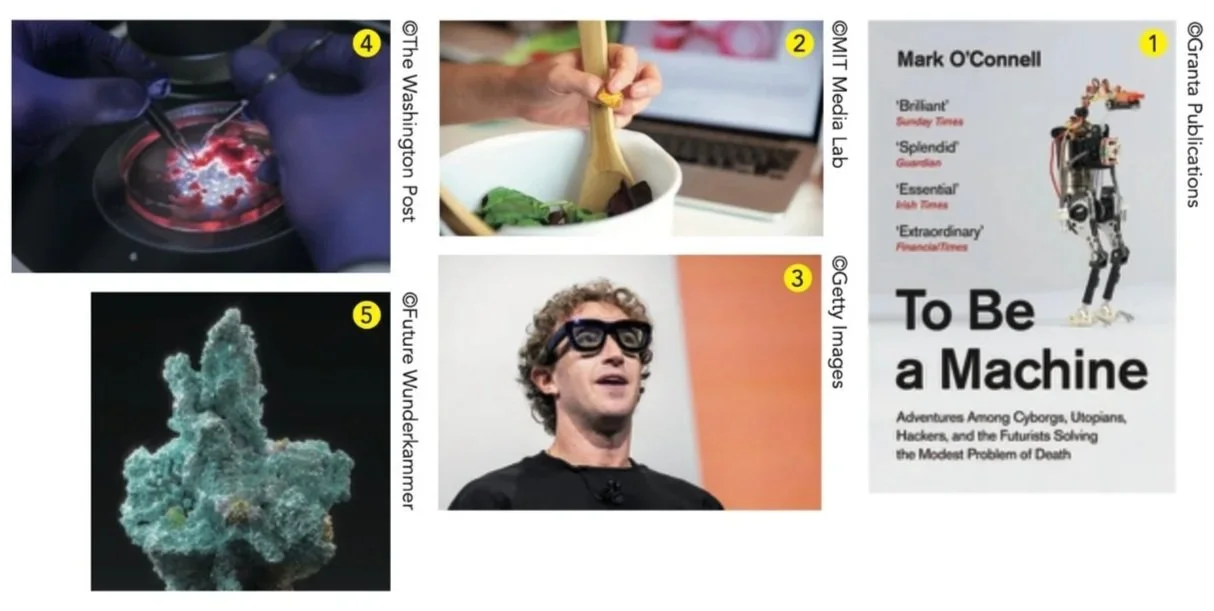From Humans to Living Connectables
The following article was originally published in SPUR magazine in my Tomorrow column.
As the world hurtles towards a future dominated by technological advancements, the lines between humans and machines are blurring in labs and big tech offices around the world, pointing to a plausible future where humans become hybrid computer interfaces. This validates the transhumanist belief that unaltered human physiology and brain function are limited. In his book To Be a Machine, Mark O'Connell stated 'Transhumanists view flesh as merely a dead format, like a floppy disk drive or VHS'.
What's the future for us mere 2020s humans? The convergence of AI, robotics and biology is driving rapid advances in brain-computer interfaces (BCIs), nanorobots, bionics, and cybernetics. Elon Musk's goal to merge humans with AI challenges our idea of human identity and consciousness. Neuralink recently obtained FDA approvals for expanded human trials beyond paralysis patients. If BCIs move from labs to clinics to consumers for human enhancement beyond medical needs, they would reshape physiological human intelligence. It no longer is a question of if, it’s a question of when.
Will we all someday have nanobots flowing through our veins and BCI implants, becoming upgraded humans requiring regular OS updates? This year’s MIT Technology Review readers selected Brain-computer interfaces for their 10 Breakthrough Technologies report. But the first time a person controlled a computer from a brain implant dates back to 1998 at Emory University in Atlanta.
When we venture into non-medical applications, BCIs, nanorobots, bionics, and cybernetics get murky. What if they gave faster reasoning and memory skills, or cognitive abilities, at a premium price only accessible to the privileged few? How would it create a divide between enhanced and non-enhanced populations?
It is however key to understand until recently, BCIs have been developed to help people living with debilitating conditions. In 2023, scientists reconstructed a Pink Floyd song by listening to people’s brainwaves, raising hopes that the musicality of natural speech can be restored in patients with disabling neurological conditions. A breakthrough brain implant and digital avatar has allowed a stroke survivor to speak with facial expressions for the first time in 18 years. The Swiss Federal Institute of Technology recently developed a miniaturized brain-machine interface that translates neural signals into text, helping individuals with severe motor impairments communicate. The list goes on.
Yet a different kind of integration of neural interface is underway, designed to seamlessly integrate into daily life. A decade ago, Cornell’s Hybrid Body Lab created NailO, a prototype where a commercialized nail art sticker served as a miniaturized trackpad. Fast forward to Meta’s Connect 2024 conference, CEO Mark Zuckerberg shared the development of a “neural interface” that can be used to control its upcoming Orion AR glasses. At UT Austin, scientists developed a lightweight wireless electronic tattoo for continuous heart monitoring that produces comprehensive cardiac health reports. Project this into the future: what if these wearables became the future of health tracking replacing apps and integrated into Apple’s suite of devices? The key is to question these innovations when developed by social media companies for commercial purposes, versus a medical institution.
We are also rewriting our biology from within. Nanobots, science fiction until recently, are tiny robotic devices at nanometre scale that perform tasks such as drug delivery or cellular repair. MIT has developed programmable nanobots that can target multiple diseases simultaneously. In 2024 University of Pennsylvania researchers created magnetically controlled nanorobots generating antimicrobial molecules eliminating fungi within 10 minutes. At Shenzhen Institute of Advanced Technology, self-propelling TBY-robots offer precise gastrointestinal inflammatory therapy.
Project this into the future: The Future Today Institute, a leading strategic foresight consulting firm founded by Amy Webb developed the 2045 scenario 'A New Kind of High', depicting a world where “nanobots initially designed for medical applications are used for cognitive and emotional manipulation, navigating to brain regions responsible for emotional regulation, inducing desired states from heightened happiness to suppressed anxiety.” In this plausible scenario, users become increasingly dependent, losing touch with their natural capacity to experience emotions, differentiate artificial and genuine emotional experiences.
These possibilities challenge our understanding of human agency and emotional authenticity. Back in the present day, scientists are already decoding the fundamentals of creativity and our drive to explore and discover. Research from Columbia University's Zuckerman Institute could potentially inform more personalized BCIs that respond to users' curiosity and mental states. We could crack the code of creativity, the enthusiasm that leads us to explore. How could this potentially be used for commercial, social media and marketing purposes?
On the flip side, robots could now look more human. Taking inspiration from human skin ligaments, a team led by Professor Shoji Takeuchi of the University of Tokyo has been able to bind engineered skin tissue to humanoid robots. “This brings with it potential benefits to robotic platforms such as increased mobility, self-healing abilities, embedded sensing capabilities and an increasingly lifelike appearance.” Whilst the research claims to be useful in the cosmetics industry and to help train plastic surgeons, how could it be used in other ways?
In a transhumanist world, living as a human connectable, a key feature of our society will be the ability to replace body parts. Bioprinting and synthetic biology already enable rebuilding human parts with living materials. An organoid is a miniaturised and simplified version of an organ produced in vitro, mimicking the key functional, structural, and biological complexity of that organ. University of Oxford researchers fabricated two-layered brain tissue from 3D printing human neural stem cells which shows promise for repairing brain injuries. Scientists at Stanford and University of Pennsylvania successfully transplanted human brain organoids into damaged rat brains. The same year a Stanford team has also received $26.3 million to 3D bioprint a fully functioning human heart within five years.
This leads us to ask what is the human experience becoming? The ethical implications of brain to computer interfaces, invisible wearables, printed organs and body parts require existential guardrails with privacy and cybersecurity being only the tip of the iceberg. With these developments blurring the line between human and machine, ethical and regulatory efforts are now underway with the EU's Neural Rights legislation proposals for brain data protection, California's Mental Privacy Act covering neural data ownership and UNESCO's recommendations on cognitive enhancement ethics.
Artists, scientists, and philosophers are also asking What Will Life Become? in projects such as the Berggruen Institute’s Future Wunderkammer interactive platform. “We are developing novel technologies and tools that are dismantling traditional notions of the liberal human subject, reshaping how we humans think of the nature of consciousness, the boundary between the biological and the synthetic, and our evolution with multispecies kin.”
Parting Thoughts
Artificial intelligences, biological robots invite new possibilities of what it means to be human. If our embodied experience increasingly merges with supporting technology, are we willing participants or passive bystanders? What kind of "living connectable" do we choose to become?
By Geraldine Wharry



